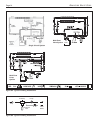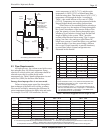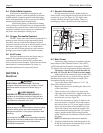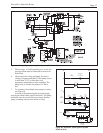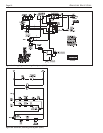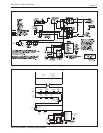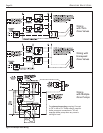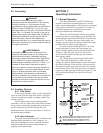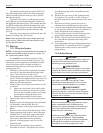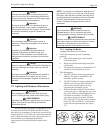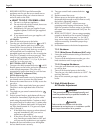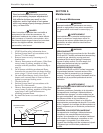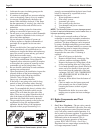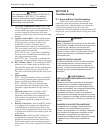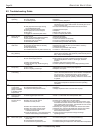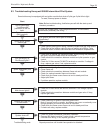
BRADFORD WHITE CORP.
Page 22
On continuous pilot ignition models (BJVT), if
the water temperature is below the limit setting, the
ignition module opens the main gas valve, and the
main burners ignite.
Operation will continue on all ignition systems
until either the wall setting thermostat is satisfied or
the high-limit thermostat opens. The burners and pilot
(on BJVS models) shut-off and the pump relay turns
off the pump. The damper activator rotates the damper
blade to the closed position and the indicator light
goes off.
When the room temperature falls below the wall
thermostat setting, the cycle repeats.
Note: When equipped with a pump delay option, the
pump runs for a short time after the burners turn off
and the damper closes.
7.2 Start-up
7.2.1 Filling the System
NOTE: It is strongly recommended that the system be
cleaned and flushed to remove scale, oil, paste, flux,
etc., before the system is filled.
It is crucial to the efficient operation of the
system that all air be removed from the circuit. For
this reason, an air scoop and vent should be located
close to the boiler outlet, and there should be a
minimum distance between cold water feed and
system purge valve.
1. When the system has been completely installed,
close all air vents and open the makeup water
valve. Allow the circuit to fill slowly.
2. Adjust the pressure to provide a minimum of 12
psi (82.7kPa) at the highest point in the circuit. If
a pressure regulator is also installed in the line,
adjust it to the same pressure.
3. Close all gate valves. Purge one circuit at a time
as follows:
a. Open one circuit drain valve and let water
drain out for at least 5 minutes. Be certain
there are no air bubbles visible in the water
stream before closing the drain valve.
b. Repeat this procedure for each circuit.
4. Open all gate valves after all circuits have been
purged.
5. Run the system circulating pump for a minimum
of 30 minutes with the boiler shut off.
6. Open all strainers in the system, and check for
debris.
7. Recheck all air vents as described in Step 3 above.
8. Some expansion tanks require visual inspection
of liquid level. If necessary, inspect the liquid
level in the expansion tank. With the system
full of water, and under normal operating
pressure, to ensure proper water level in the
expansion tank.
9. Start up boiler according to the procedures
described in Section 7 and operate the system,
including the pump, boiler, and radiation units,
for one hour.
10. Recheck the water level in the expansion tank,
if necessary. If it exceeds ½ of the volume of
the tank, open the tank drain and reduce the water
level.
11. Shut down the entire system, and vent all
radiation units and high points in the system.
12. Close the water makeup valve and check the strainer
in the pressure reducing valve for sediment or
debris. Reopen the water makeup valve.
13. Verify system pressure with the boiler pressure
gauge before beginning regular operation.
14. Within 3 days of start-up, recheck and bleed all
air vents and the expansion tank using these
instructions.
15. In systems piped with cross-linked polyethylene
tubng (PEX) it is essential that all air is purged
from all zones in the system to prevent PEX
tubing failure.
7.2.2 Boiler Start-up
WARNING
For your safety, when starting the boiler, keep your
head and face well away from the burner area to
prevent any risk of personal injury.
AVERTISSEMENT
Pour votre sécurité personnelle lorsque vous mettez
l’appareil en marche, tenez votre tête et votre visage
loin du brûleur pour éviter tout risque de blessure.
WARNING
Vent pipes, and heater tops get hot! These
surfaces can cause serious burns. Do not touch
these surfaces while the heater is in operation.
AVERTISSEMENT
Les tuyaux d’aération et le dessus de l’appareil
deviennent chauds! Ils peuvent causer de graves
brûlures. Ne touchez pas à ces surfaces lorsque
l’appareil est en marche.
Caution
Do not use this boiler if any part has been under
water. Immediately call a qualified service
technician to inspect the heater and replace any
part of the control system and any gas control
which has been under water.
Attention
N’utilisez pas cet appareil s’il a été plongé dans
l’eau, même partiellement. Faites inspecter
l’appareil par un technicien qualifié et remplacez
toute partie du systéme de contrôle et toute
commande qui ont été plongés dans l’eau.



